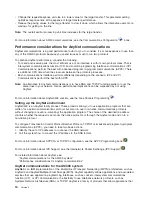
v
Use the following table for the device description parameter.
AS/400 Prompt
AS/400
Parameter
Host Definition
Statement
Host Parameter
Local location name
LCLLOCNAME
DFHTCT
NETNAME
AS/400 LCLLOCNAME value must match CICS/VS
terminal control table NETNAME parameter and the
label used on the LU definition statement.
Local location address LOCADR
LU
LOCADDR
Values specified for each system must match.
The LOCADDR parameter is a decimal value (0-255);
the AS/400 value is specified as a 2-digit hexadecimal
number.
Location password
LOCPWD
DFHTCT
BINDPWD
Values specified for each system must match.
Dependent location
name
DEPLOCNAME
LU
LU
This parameter is only used for DLUR support. This
value is optional. If specified, it must match LUNAME
received on ACTLUREQUEST.
Mode description
name
MODE
MODEENT
LOGMODE
AS/400 mode description name must be defined in the
host logon mode table using the LOGMODE parameter
on the MODEENT macro instruction. The mode name
must also be included in the CICS/VS terminal control
table (DFHTCT) MODENAM parameter.
Remote location name RMTLOCNAME
LU
LOGAPPL
Values specified for each system must match.
Remote network
identifier
RMTNETID
BUILD
NETID
Values specified for each system must match.
For more information on AS/400 parameters, see Communications Configuration.
Matching AS/400 mode and class-of-service description parameters for
a host system
You must match host system communications configuration parameters with AS/400 values. A description
of the AS/400 values are in the following table. For information about configuring host systems, see the
manuals
VTAM Installation and Resource Definition
, SC23-0111, and
Network Control Program Resource
Definition Reference
, SC30-3254.
You can specify some host system parameters on multiple definition statements, such as the GROUP,
LINE, PU, and LU. The following table lists only the lowest level definition statement that is used by the
host system.
To configure an AS/400 to a host system:
v
See “Examples: Connecting AS/400 to a host system” on page 26 for an example of connecting an
AS/400 to a host system.
v
Use the following table for the mode and class-of-service description parameter.
Chapter 5. Communicating with host systems
25
Summary of Contents for AS/400
Page 1: ...iSeries Networking iSeries Communications Management ERserver...
Page 2: ......
Page 3: ...iSeries Networking iSeries Communications Management ERserver...
Page 8: ...2 Version 5...
Page 10: ...4 Version 5...
Page 12: ...6 Version 5...
Page 22: ...For more information about creating subsystems see the Work Management book 16 Version 5...
Page 26: ...20 Version 5...
Page 34: ...Example 3 AS 400 system for DLUR support with the host system 28 Version 5...
Page 36: ...30 Version 5...
Page 46: ...40 Version 5...
Page 57: ...Chapter 7 Communicating with remote workstation controllers 51...
Page 63: ...Chapter 7 Communicating with remote workstation controllers 57...
Page 82: ...Example 2 AS 400 to 4690 PEER connection over token ring network 76 Version 5...
Page 83: ...Chapter 7 Communicating with remote workstation controllers 77...
Page 84: ...78 Version 5...
Page 102: ...96 Version 5...
Page 103: ......
Page 104: ...Printed in U S A...






























